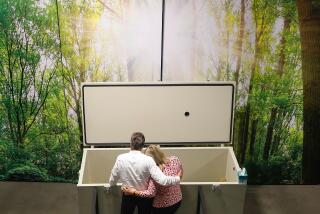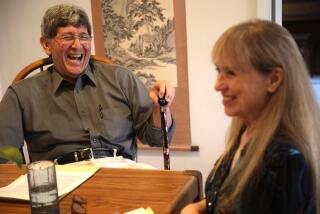‘Have I made medical history yet?’ : Marrow Transplant Carries Girl’s Hope of Beating Cancer
It took only 10 minutes for the salmon-pink liquid to flow into her arm, but for a 9-year-old cancer patient from Huntington Beach, Wednesday afternoon’s transfusion of her own bone marrow was the last, hopeful step in a long, dramatic process.
And for Tori Lee Glazos, the first patient to receive a bone-marrow transplant in Orange County, the next few weeks will tell whether she lives or dies.
“She’s doing better than we are,” said Lynne Glazos, Tori’s mother. “ . . . She knows she could die from this, but she knew it was her only chance.”
Cancer Very Advanced
Tori is suffering from a highly malignant muscle cancer--called rhabdomyosarcoma--that has spread to her lungs, her leg, her spine and elsewhere, her parents said.
“She came to us with very widespread disease,” said Dr. Geni Bennetts, director of hematology and oncology at Childrens Hospital of Orange County. “ . . . Even at conventional doses of chemotherapy, the tumors come back.”
So the only way to fight Tori’s cancer was by administering extremely high doses of the cancer-fighting chemicals last week, she said.
But that kind of high-powered treatment has a grave side-effect: It also kills the patient’s bone marrow--the essential tissue that produces blood cells, said Dr. Mitchell Cairo, director of cancer research at Childrens Hospital.
Anticipating that, doctors “harvested” a small fraction of Tori’s marrow, from her hip bones, several weeks ago, purified the tissue and froze it at -321 degrees Fahrenheit.
After administering “lethal doses of therapy” last week, the doctors gave Tori back her marrow Wednesday, through an intravenous tube, Bennetts said. By using Tori’s own marrow, doctors reduced the chance of rejection--which could be extremely painful and possibly even fatal--to less than 1%.
Infection ‘Virtually Inevitable’
If the procedure is successful, the marrow “cells (will) find their way back” to Tori’s bones and take root over the next few weeks.
Until then, Tori will have few disease-fighting white blood cells of her own. She will stay in a special room to isolate her from possible infection, and may have to rely on transfusions and antibiotics to fight off illness.
“She’ll feel good until she gets some kind of an infection,” Bennetts said, “. . . and that’s virtually inevitable.”
It will also take two or three weeks to learn if last week’s chemotherapy was successful in killing Tori’s tumors, Bennetts said.
During her isolation, Tori said, she plans “to watch movies and use my computer.” Some of her books are being sterilized, Tori said, so she can have them in her room.
Only about half a dozen Southland hospitals are performing bone-marrow transplants, Bennetts said, but use of the procedure--until recently considered only experimental--is spreading from research hospitals to community hospitals.
At Childrens Hospital, “we are not sure how much it’s going to cost,” Bennetts said. Elsewhere, it runs between $50,000 and $120,000.
“This is going to become a more routine therapy for high-risk patients,” Bennetts predicted.
The bone-marrow transplant team at Childrens Hospital plans to treat another patient, a 2 1/2-year-old Santa Ana girl, next week, Cairo said.
That girl, whose parents have requested anonymity, was to have received Orange County’s first marrow transplant last month, but she came down with an ear infection that prompted a delay in her treatment.
Asking for Ice Cream
A few hours after Wednesday’s transplant, which initially left her more than a little bit queasy, Tori was eagerly eating dinner and asking for ice cream--both chocolate and vanilla.
Earlier, Tori said: “I was a little bit scared. They didn’t tell me they were going to heat (the marrow) up. . . . It was just like I had a fever or something.”
After a brief nap, though, Tori’s spirits had improved. “She had a rough time up there for a while, but Tori is a fighter,” said her father, Mike. “See how she’s bounced back already!”
His wife added: “Her first words when she woke up were, ‘Have I made medical history yet?’ ”
“This wasn’t a quick decision,” the father added. “We spent a lot of time talking together” and with doctors around the country.
When Tori’s cancer was diagnosed last August, her family didn’t expect her to live until Christmas. And even though the new transplant procedure has brought a large measure of hope, they still are steeled to the possibility that the cancer may recur, or that Tori may die from infection.
“Tori was really pushing for this,” Lynne Glazos said. “There’s a lot against her, but if anyone’s gonna do it, she can.
More to Read
Sign up for Essential California
The most important California stories and recommendations in your inbox every morning.
You may occasionally receive promotional content from the Los Angeles Times.










